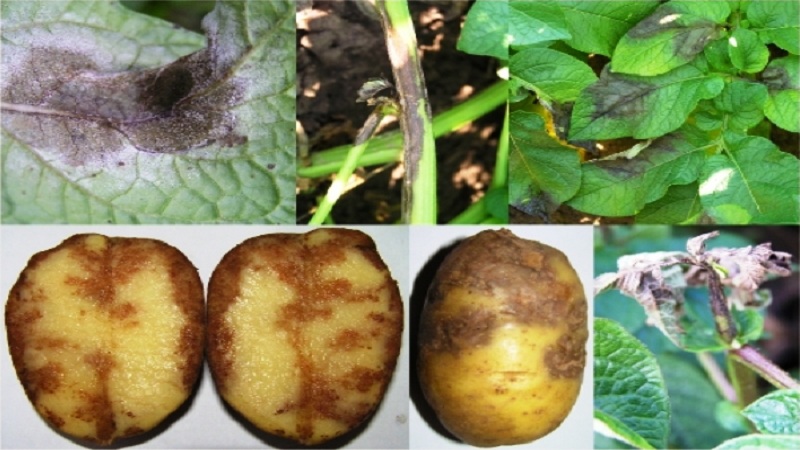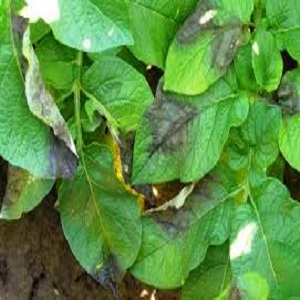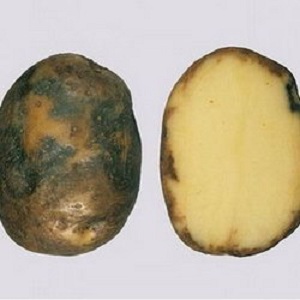What is potato late blight: a description of the disease and methods of treatment
Potato late blight is a dangerous fungal disease that is difficult to treat due to the ability of the pathogen to develop resistance to fungicides. Farmers direct the main emphasis in the fight against late blight on preventive measures, including pre-planting seed treatment, the choice of varieties resistant to fungus, spraying with copper-containing preparations.
In this article we will talk about potato late blight with a description of the disease and treatment methods.
The content of the article
What is late blight
Late blight is a disease caused by the late blight fungus. Mycelial lower organisms lead a parasitic way of life, destroying plant tissues.
Historical reference. In 1845-1849, the fungus Phytophthora infestans caused a significant spread of late blight, which led to the Great Famine in Ireland.
The photo shows potatoes affected by late blight.

Description and characteristics of the disease
For the first time, the disease was discovered practically simultaneously in the USA and Europe in 1842-1843. Presumably, phytophthora was brought from Peru during the export of Chilean nitrate in the early 1840s. The German scientist de Bary, who described the pathogen, called it "phytophthora", which literally means "plant eater."
Potato plantings are affected by the fungus Phytophthora infestans Mont. de Bary, named after the same scientist. The causative agent is activated from the end of May to August and spreads with lightning speed in conditions of high air and soil humidity, sudden changes in day and night temperatures, morning dews and fogs. Simply put, wet and cool weather is the optimal environment for the development of late blight. In the southern regions, it spreads to abundantly irrigated areas.
Potatoes are sick with late blight of tops and tubers... Damage to greens is observed at 20-50% of plantings, and tubers - by 8-23%. Crop losses are 30-50%.
Phytophthora, introduced to Europe in the 19th century, was the only causative agent of the disease of the same name until the 80s of the 20th century. In Switzerland and other European countries, a new genotype of the fungus, A2, was discovered, which differs from the previous ones in aggressiveness and the ability to easily adapt to adverse conditions.
As a result of the joint development of both forms, new sexual structures, oospores, were formed. They have a thick two-layer shell, for a long period remain viable in low temperature conditions, overwinter on tubers, tops and in the ground.
The disease began to be detected on the stems 1-4 weeks earlier than usual, the level of infection of tubers increased.
Reference. With the appearance of the A2 fungus, the disease is diagnosed in the germination phase. Oospores remain viable for 4 years, accumulate in the ground and, under favorable conditions, cause an outbreak of the disease.
Signs of late blight of potatoes
Signs of late blight of leaves:
- brown spots on the lower leaves;

- white bloom is the result of the vital activity of the fungus, by which the disease is accurately determined;
- dry foliage;
- longitudinal brown stripes on stems.
Wet and warm weather contributes to the intensive spread of late blight. In just 3-5 days, the greens turn into a dark, rotten mass. In drought, the development of the fungus is suspended, the spots dry, the leaves become brittle. With the extensive spread of the fungus, the plant dies.
Phytophthora quickly passes from a sick bush to a healthy one, forming new foci of the disease.
Signs of late blight of tubers:
- hard, depressed gray-brown spots on the surface;
- rusty-brown uneven necrosis on the pulp;
- wet or dry rot on potatoes.
Reference. Spores germinate in drops of water or dew at an air temperature of + 4 ... + 30 ° C and are carried by air streams.
Reasons for infection
The development cycle of phytophthora occurs in two ways: the infection develops on the sprouts of infected seeds or on potatoes discarded after digging. After the primary infection of the bushes, several repeated waves of infection occur on the site, which directly depend on weather conditions.
Infection occurs during harvesting - when tubers come into contact with potato tops. The infectious cycle is closed in the repository.
Control methods
To combat late blight of potatoes, treatment with chemicals and folk remedies is used.
Traditional methods
How to deal with late blight on potatoes with folk remedies?
Gardeners use the following medicinal solutions:
- Dilute milk whey or milk with a fat content of 1% with water in a 1: 1 ratio. Use the solution for spraying bushes, starting in July, every 2-3 days. To enhance the action, add 15 drops of iodine per 1 liter of liquid.

- Dissolve a pack of "live" yeast (100 g) in 10 liters of water. Treat plants at the first signs of late blight 2 times a week.
- Pass 200 g of garlic arrows through a meat grinder, pour 200 ml of warm glass of water and leave for 24 hours. Strain the infusion and dilute 10 liters of water. Add 1 g of potassium permanganate to the liquid. Spraying of plantings should be carried out every 10 days.
- 1 kg of nettle and bitter wormwood pour 10 liters of water and leave for 24 hours. Then strain and add 50 g of soap shavings. Spray greens once every 10-12 days.
- Before flowering, treat the bushes with a solution of copper sulfate (2 tablespoons of powder per 10 liters of water).
- Mix 1 liter can of wood ash with 200 g of tar soap shavings and pour 10 liters of water. Carry out processing at any time.
- Infusion of mullein 1 liter pour 10 liters of water, leave for 1 hour. Spray plants before flowering.
- Chop 100 g of dried tinder fungus with a sharp knife, put in a non-metallic container and pour 1 liter of boiling water. Leave to cool completely, strain and use for processing potato plantings 1 time in 10 days.
Natural products are safe for plants, humans, birds and bees. Combined use and alternation increases their efficiency and prevents crop loss.
Chemicals
The most effective are combined preparations with systemic and contact substances in the composition. Processing them makes it possible to suspend the development of the fungus for 20-30 days and reduce crop losses.
The first and second preventive spraying with combined agents is carried out at the stage of closing the tops in rows, without waiting for the first symptoms to appear.
With an early manifestation of the disease, systemic drugs are first used, then the bushes are sprayed with contact agents according to the scheme:
- systemic chemicals: "Ridomil Gold", "Quadris", "Thanos", "Infinito", "Tattu", "Ordan", "Acrobat MC" - every 10-12 days;
- contact: "Antrakol", "Azofos", "Ditan", "Buzzer" - every 7-8 days.
In humid and warm weather, the break between treatments is reduced to 5 days.
A week before harvesting, spraying is stopped, the potato tops are cut and completely removed from the site. With late harvesting of the ground part, the accumulation of fungus and massive infection of tubers occurs.
Digging potatoes is carried out in dry weather. In case of forced harvesting in rainy weather, the tubers are folded under a canopy or in bays with ventilation. For 2-3 weeks, potatoes are sorted, damaged and diseased specimens are discarded and transferred to storage.
"Epin"
"Epin" is an analogue of a natural plant growth stimulant with an anti-stress effect.It increases the defenses and productivity of plants, stimulates the development of roots and stolons, accelerates the ripening of potatoes, and reduces the amount of nitrates and pesticides. The product is used for spraying green mass and soaking seeds before planting.
Reference. Due to massive counterfeits, the drug "Epin" was discontinued in 2003, but released to replace "Epin-extra" with a greater degree of protection against counterfeiting.
The preparation contains the synthesized substance epibrassinolide, which is responsible for accelerating biological processes in plants and increasing stress resistance.
The tool is released in ampoules of 0.25 mg and used strictly according to the instructions, avoiding overdose. The solution is thoroughly mixed and used on the day of preparation. It is advisable to add citric acid to the water from the water supply at the tip of a knife - the alkali contained in it reduces the effect of the active substance.
The table shows the scheme of using "Epin".
| Processing period | Consumption | Application |
| Preplanting tubers | 1 ml and 250 ml of water for 50 kg of seeds | Spray 2 hours before disembarkation |
| Budding | 1 ampoule and 5 l of water | Once |
Spraying of potato bushes is carried out in the morning or in the evening due to a decrease in the activity of the active substance in direct sunlight. The leaves are sprayed on both sides. Under stressful conditions - with drought, lack of light, the first signs of late blight - the treatment is carried out once a week until complete recovery. Preventive spraying is recommended 3 times a season.
"HOM"
"HOM" is a copper-containing fungicide to combat late blight, contains copper oxychloride (861 g / kg). Analogs - "Oxyhom", "Polyhom", "Bordeaux mixture".
Potatoes are processed during the growing season. To prepare the working solution, take 40 g of the substance per 10 liters of water. Consumption per 100 sq. m - 6–8 liters. The number of treatments is 5, the period of validity is 28-30 days.
The solution is poured into a spray bottle and the leaves are sprayed from above and below in the morning or evening.
"Trichopol"
«Trichopolus"- a pharmacy antimicrobial and antiprotozoal drug containing metronidazole. The active ingredient affects the DNA cells, causing the death of microorganisms.
Experienced gardeners advise using the drug together with a 1% solution of brilliant green, which heals wounds on the leaves, stopping the development of phytophthora.
Reference. "Trichopolum" with brilliant green is used only for preventive purposes and in the early stages of the disease. The tool is ineffective as a remedy for mass infection of plantings.
Solution recipe:
- 10 Trichopolum tablets;
- 35-40 drops of brilliant green;
- 10 liters of water.
Grind the tablets into powder, pour into water and add brilliant green. Mix thoroughly, pour into a container and treat the bushes with a spray bottle. The frequency of treatment is once every two weeks every 10 days.
Prevention measures
Prevention of potato late blight includes:
- breeding resistant varieties;
- selection of healthy seed;
- disinfection of tubers with fungicides before planting;
- warming up and germinating seeds;
- re-sorting of potatoes after germination (at a temperature of + 15 ... + 17 ° C, even the smallest spots of late blight grows for 15-25 days);
- disposal of potato residues after spring sorting;
- crop rotation;
- planting potatoes away from tomatoes, eggplants and peppers;
- introduction of balanced organic and mineral dressings.
Read also:
How to deal with late blight on tomatoes in a greenhouse using folk methods.
How to deal with late blight on tomatoes: the best methods and practical advice.
Potato varieties resistant to late blight
The table contains varieties that are resistant to late blight.
| Name | Originator | Ripening period | Mass of tubers | Yield |
| Madeline | AGRICO U.A. | 70-80 days | 84-118 g | 164–327 c / ha |
| Early | FSBSI "All-Russian Research Institute of Potato Farming" A.G. Lorkha " | 45-50 days | 62-128 g | 140-350 c / ha |
| Luck | FSBSI "All-Russian Research Institute of Potato Farming" A.G. Lorkha " | 55-60 days | 120-250 g | 300-500 c / ha |
| Reserve | FSBSI "All-Russian Research Institute of Potato Farming" A.G. Lorkha " | 40–55 days | 80-90 g | 300-420 c / ha |
| Nevsky | FSBSI "Leningrad Scientific Research Institute of Agriculture" Belogorka " | 75-90 days | 90-130 g | 280-360 c / ha |
| Blue | FSBSI "All-Russian Research Institute of Potato Farming" A.G. Lorkha " | 100-115 days | 90-110 g | 400-500 c / ha |
| Lugovsky | "Institute of Potato Growing of the Ukrainian Academy of Agrarian Sciences" | 70-80 days | 85-125 g | 380-514 c / ha |
| Timo Hankkiyan | JSC "HC-ZET-PI-SI SADOKAS" | 50-65 days | 65-120 g | 237–382 c / ha |
| Red Scarlett | HZPC HOLLAND B.V. | 70-80 days | 56-102 g | 164-270 c / ha |
Is it possible to eat potatoes affected by late blight
Potatoes with signs of late blight are safe for humans. You can eat it, but first you need to cut off the rotten parts on the potatoes.
Reference. Heat treatment completely kills the spores of the fungus.
Conclusion
Gardeners know about late blight of potatoes firsthand. This is one of the most common diseases, the fight against which often lasts the entire season. The danger of late blight lies in the lightning spread of fungal spores by the wind. High humidity and high air temperature are an ideal environment for the development of late blight.
Work to prevent the disease is aimed at disinfection of tubers before planting, treatment with growth stimulants to increase immunity, preparations with copper "Khom, Oksikh". The fungicides Ridomil Gold, Quadris, Thanos, Infinito, Tattu, Ordan, Acrobat MC, Azofos, Ditan are used to treat the plant.